Hold down the T key for 3 seconds to activate the audio accessibility mode, at which point you can click the K key to pause and resume audio. Useful for the Check Your Understanding and See Answers.
Waves come in many shapes and forms. While all waves share some basic characteristic properties and behaviors, some waves can be distinguished from others based on some observable (and some non-observable) characteristics. It is common to categorize waves based on these distinguishing characteristics.
Longitudinal versus Transverse Waves versus Surface Waves
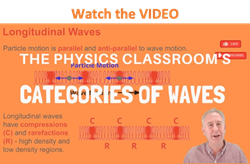 One way to categorize waves is on the basis of the direction of movement of the individual particles of the medium relative to the direction that the waves travel. Categorizing waves on this basis leads to three notable categories: transverse waves, longitudinal waves, and surface waves.
One way to categorize waves is on the basis of the direction of movement of the individual particles of the medium relative to the direction that the waves travel. Categorizing waves on this basis leads to three notable categories: transverse waves, longitudinal waves, and surface waves.
A transverse wave is a wave in which particles of the medium move in a direction perpendicular to the direction that the wave moves. Suppose that a slinky is stretched out in a horizontal direction across the classroom and that a pulse is introduced into the slinky on the left end by vibrating the first coil up and down. Energy will begin to be transported through the slinky from left to right. As the energy is transported from left to right, the individual coils of the medium will be displaced upwards and downwards. In this case, the particles of the medium move perpendicular to the direction that the pulse moves. This type of wave is a transverse wave. Transverse waves are always characterized by particle motion being perpendicular to wave motion.
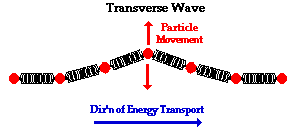
A longitudinal wave is a wave in which particles of the medium move in a direction parallel to the direction that the wave moves. Suppose that a slinky is stretched out in a horizontal direction across the classroom and that a pulse is introduced into the slinky on the left end by vibrating the first coil left and right. Energy will begin to be transported through the slinky from left to right. As the energy is transported from left to right, the individual coils of the medium will be displaced leftwards and rightwards. In this case, the particles of the medium move parallel to the direction that the pulse moves. This type of wave is a longitudinal wave. Longitudinal waves are always characterized by particle motion being parallel to wave motion.
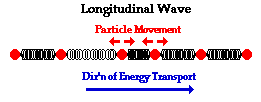
A sound wave traveling through air is a classic example of a longitudinal wave. As a sound wave moves from the lips of a speaker to the ear of a listener, particles of air vibrate back and forth in the same direction and the opposite direction of energy transport. Each individual particle pushes on its neighboring particle so as to push it forward. The collision of particle #1 with its neighbor serves to restore particle #1 to its original position and displace particle #2 in a forward direction. This back and forth motion of particles in the direction of energy transport creates regions within the medium where the particles are pressed together and other regions where the particles are spread apart. Longitudinal waves can always be quickly identified by the presence of such regions. This process continues along the chain of particles until the sound wave reaches the ear of the listener. A detailed discussion of sound is presented in another unit of The Physics Classroom Tutorial.
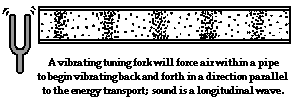
Waves traveling through a solid medium can be either transverse waves or longitudinal waves. Yet waves traveling through the bulk of a fluid (such as a liquid or a gas) are always longitudinal waves. Transverse waves require a relatively rigid medium in order to transmit their energy. As one particle begins to move it must be able to exert a pull on its nearest neighbor. If the medium is not rigid as is the case with fluids, the particles will slide past each other. This sliding action that is characteristic of liquids and gases prevents one particle from displacing its neighbor in a direction perpendicular to the energy transport. It is for this reason that only longitudinal waves are observed moving through the bulk of liquids such as our oceans. Earthquakes are capable of producing both transverse and longitudinal waves that travel through the solid structures of the Earth. When seismologists began to study earthquake waves they noticed that only longitudinal waves were capable of traveling through the core of the Earth. For this reason, geologists believe that the Earth's core consists of a liquid - most likely molten iron.
While waves that travel within the depths of the ocean are longitudinal waves, the waves that travel along the surface of the oceans are referred to as surface waves. A surface wave is a wave in which particles of the medium undergo a circular motion. Surface waves are neither longitudinal nor transverse. In longitudinal and transverse waves, all the particles in the entire bulk of the medium move in a parallel and a perpendicular direction (respectively) relative to the direction of energy transport. In a surface wave, it is only the particles at the surface of the medium that undergo the circular motion. The motion of particles tends to decrease as one proceeds further from the surface.

Any wave moving through a medium has a source. Somewhere along the medium, there was an initial displacement of one of the particles. For a slinky wave, it is usually the first coil that becomes displaced by the hand of a person. For a sound wave, it is usually the vibration of the vocal chords or a guitar string that sets the first particle of air in vibrational motion. At the location where the wave is introduced into the medium, the particles that are displaced from their equilibrium position always moves in the same direction as the source of the vibration. So if you wish to create a transverse wave in a slinky, then the first coil of the slinky must be displaced in a direction perpendicular to the entire slinky. Similarly, if you wish to create a longitudinal wave in a slinky, then the first coil of the slinky must be displaced in a direction parallel to the entire slinky.
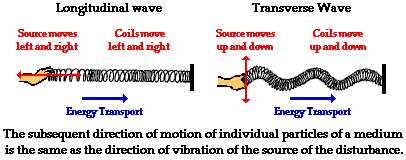

Electromagnetic versus Mechanical Waves
Another way to categorize waves is on the basis of their ability or inability to transmit energy through a vacuum (i.e., empty space). Categorizing waves on this basis leads to two notable categories: electromagnetic waves and mechanical waves.
An electromagnetic wave is a wave that is capable of transmitting its energy through a vacuum (i.e., empty space). Electromagnetic waves are produced by the vibration of charged particles. Electromagnetic waves that are produced on the sun subsequently travel to Earth through the vacuum of outer space. Were it not for the ability of electromagnetic waves to travel to through a vacuum, there would undoubtedly be no life on Earth. All light waves are examples of electromagnetic waves. Light waves are the topic of another unit at The Physics Classroom Tutorial. While the basic properties and behaviors of light will be discussed, the detailed nature of an electromagnetic wave is quite complicated and beyond the scope of The Physics Classroom Tutorial.

A mechanical wave is a wave that is not capable of transmitting its energy through a vacuum. Mechanical waves require a medium in order to transport their energy from one location to another. A sound wave is an example of a mechanical wave. Sound waves are incapable of traveling through a vacuum. Slinky waves, water waves, stadium waves, and jump rope waves are other examples of mechanical waves; each requires some medium in order to exist. A slinky wave requires the coils of the slinky; a water wave requires water; a stadium wave requires fans in a stadium; and a jump rope wave requires a jump rope.
The above categories represent just a few of the ways in which physicists categorize waves in order to compare and contrast their behaviors and characteristic properties. This listing of categories is not exhaustive; there are other categories as well. The five categories of waves listed here will be used periodically throughout this unit on waves as well as the units on sound and light.
Earthquakes and other geologic disturbances sometimes result in the formation of seismic waves. Seismic waves are waves of energy that are transported through the earth and over its surface by means of both transverse and longitudinal waves. Just how common are seismic waves? Use the Recent Earthquakes widget below to explore the frequency of earthquakes. Search the past week or the past 24 hours or by Richter scale magnitude.
We Would Like to Suggest ...

Why just read about it and when you could be interacting with it? Interact - that's exactly what you do when you use one of The Physics Classroom's Interactives. We would like to suggest that you combine the reading of this page with the use of our
Simple Wave Simulator. You can find it in the Physics Interactives section of our website. The
Simple Wave Simulator provides the learner an enivronment to explore the distinction between longitudinal and transverse waves, the wavelength-frequency-period relationship, sound waves as pressure waves, and much more.
Check Your Understanding
1. A transverse wave is transporting energy from east to west. The particles of the medium will move_____.
a. east to west only
b. both eastward and westward
c. north to south only
d. both northward and southward
2.A wave is transporting energy from left to right. The particles of the medium are moving back and forth in a leftward and rightward direction. This type of wave is known as a ____.
|
a. mechanical
|
b. electromagnetic
|
|
c. transverse
|
d. longitudinal
|
3. Describe how the fans in a stadium must move in order to produce a longitudinal stadium wave.
4. A sound wave is a mechanical wave, not an electromagnetic wave. This means that
a. particles of the medium move perpendicular to the direction of energy transport.
b. a sound wave transports its energy through a vacuum.
c. particles of the medium regularly and repeatedly oscillate about their rest position.
d. a medium is required in order for sound waves to transport energy.
5. A science fiction film depicts inhabitants of one spaceship (in outer space) hearing the sound of a nearby spaceship as it zooms past at high speeds. Critique the physics of this film.
6. If you strike a horizontal rod vertically from above, what can be said about the waves created in the rod?
a. The particles vibrate horizontally along the direction of the rod.
b. The particles vibrate vertically, perpendicular to the direction of the rod.
c. The particles vibrate in circles, perpendicular to the direction of the rod.
d. The particles travel along the rod from the point of impact to its end.
7. Which of the following is not a characteristic of mechanical waves?
a. They consist of disturbances or oscillations of a medium.
b. They transport energy.
c. They travel in a direction that is at right angles to the direction of the particles of the medium.
d. They are created by a vibrating source.
8. The sonar device on a fishing boat uses underwater sound to locate fish. Would you expect sonar to be a longitudinal or a transverse wave?